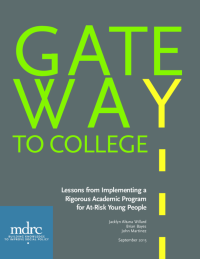Gateway to College
Lessons from Implementing a Rigorous Academic Program for At-Risk Young People

Despite efforts to improve the high school graduation rate in the United States, an estimated 7,200 students drop out of high school every day — a staggering 1.3 million every year. Further, a recent report by the Center on Education and the Workforce at Georgetown University projects that by 2020, nearly 65 percent of U.S. jobs will require at least some college education, out of reach for those who are unable to earn a high school diploma. Much more comprehensive alternative education programs are needed that put dropouts and students at risk of dropping out on a path to earn high school diplomas while also providing them with the academic skills and support necessary to be successful in their postsecondary pursuits.
Gateway to College provides a comprehensive alternative education program in which students work toward earning their high school diplomas while simultaneously earning credits toward an associate’s degree or postsecondary certificate. It is uniquely ambitious in providing struggling students with opportunities often reserved for the highest achievers, in the belief that high expectations and the right support can help more students complete high school and transition to college.
This report describes the implementation of Gateway to College. It has two main goals. The first is to provide an in-depth account of the Gateway to College model and to more precisely define the youth population the program serves. A clearer picture of the service population can provide insight into Gateway to College’s unique value and identify the students who might benefit most from it. The second goal is to describe the implementation of the Gateway to College model at three sites, assess the extent to which it is implemented as designed at those sites, and draw lessons for other Gateway to College sites.
The implementation study is guided by the following research questions:
- What are the core elements of the Gateway to College model? Whom does the model serve?
- Were the core elements of the Gateway to College model implemented as planned?
- What kinds of adaptations were made to meet the demands of the local context and the needs of the local student population?
- What factors facilitated or impeded successful program implementation?
This study finds that, at a broad level, the three study sites implemented the Gateway to College model as designed. However, Gateway to College struggled with finding the right balance between being flexible and providing concrete guidelines for implementation. The same would be true of any program serving at-risk and dropout young adults that is interested in implementing a flexible model on a large scale, but given the challenges the program sites faced with retaining students, Gateway to College may need to take a close look at which aspects of the model need to be bolstered, consider setting clearer guidelines about what implementation practices are in line with the model’s core principles and values, and strengthen the mechanisms by which the program’s National Network provides ongoing training and support. All of these are natural next steps in the program’s evolution.






